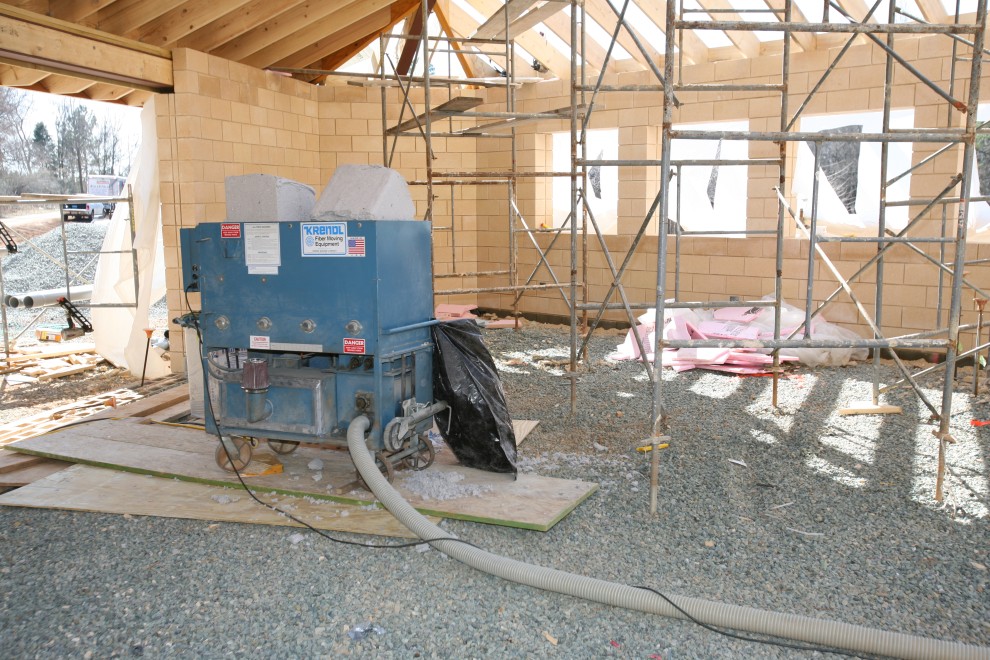


Mike, in Texas, has been asking some interesting questions about wrapping a post and beam frame with tubes of rice hulls. He thinks this is probably the fastest way to build an earthbag house. He may very well be right. Conversations and blog posts like this one are my favorite. Here’s part of my email reply to Mike.
Previously I reported on the rice hull house in Thailand that was a success. The owner has agreed to write a follow-up report soon that we’ll publish here when available. So we know rice hulls will work under certain conditions. The main issue is keeping the hulls dry.
Here are some suggestions for speeding construction. Note how all the machines could be rented so you don’t have to invest in a lot of expensive equipment. You could rent a cellulose machine (blower) and blow rice hulls through a hose into earthbag tubes. (Tubes are faster than bags.) This would take about one day like you said. But you have to figure out how to stabilize the tubes (hold them in a vertical plane and prevent from shifting around). I would put 4×4 posts or round poles about 3′-4′ apart to align with windows, doors and corners. A posthole auger would make quick work of digging holes. Build the roof before proceeding. Factory made trusses are fast and efficient. Now you’re ready to fill the tubes. Put the tubes on the outside of the posts and attach to backside of posts with baling twine. Put baling twine between tubes for later attachment of plaster mesh. Spray the walls with plaster using a mortar sprayer. Use wide roof overhangs and/or wrap-around porches so the rice hulls never get wet and so you can use earth plaster to save money. First 2-3 courses are gravel bags/tubes to prevent moisture problems. In Texas you could make the rubble trench flush with the ground and use just two courses of gravel bags/tubes. Post and beam with factory trusses and engineer’s stamp would enable bank financing, contractor sales, building permits and insurance if necessary.
Earthbag is super simple. But for those just starting out, my earthbag building book and DVD are now available. Everything is explained in great detail.
Below is a work schedule based on a modest sized home with experienced crew and mechanized system (cement mixer, truck to bring the sand and cement right where it’s needed, post hole auger, insulation blower):
Day 1: Dig trench and post holes, rough plumbing, fill trench with gravel, set posts in concrete
Day 2: Set beam, fill 2-3 courses of gravel bags (back truckload of gravel right next to work area)
Day 3: Set trusses, sheath roof, install metal roofing
Day 4:, Fill tubes with rice hulls
Day 5: Minor carpentry (windows, doors, interior walls), run electrical, attach mesh
Day 6, 7, 8: Spray plaster (move mixer and materials right where it’s needed)
Day 9: Earth floor (see blog post on 11 different earth floor methods)
Day 10: Ceiling, finish electrical and plumbing
Image source: Manifold Recording
Image source: Taylor Rental
Image source: Save My Gardening Tips
YouTube: Rice hulls are an excellent building material.

And… the research continues…
We are renting an S220 bobcat for a week as of tomorrow… during which time I hope to — among other things, to have the walls up for our house.
Now, I have decided against building with rice hulls alone… will be trying to mix the caliche at the building site with the clay soil from another area of our property for the recommended adobe mixture…
On round vs rectangular, probably going round… not sure how high, though.
I want the structure to be pretty much earth sheltered… and safe from tornadoes, extreme temperatures, etc.
It doesn’t make any sense to me to build something I need to buy insurance for… I will call it the flood-proof, fire-proof, bloated-property tax proof, mortgage-proof, extreme temperature proof, high light bill proof, noise-proof, starvation-proof (entire exterior of home can be garden), insurance proof, and weather-proof home that can be here for my children and their children when the neighbors’ million-dollar home has long been destroyed.
Anyway, a couple more Qs…:
The landing page on this site shows a home that looks very small… maybe its an above ground root cellar? It looks like the end result of what mine hopes to be, though, other than the size.
I think I read on the blog here somewhere that the diameter’s limit on roundhouses are around 15′ without buttressing? How about height?
Any special instructions for building a home 1 room at a time?
Are there any special instructions for a roof like the one shown on the landing page?
Lastly (for now), with the earth being beamed completely up to the roof, are there any special requirements for ensuring stability so to avoid inward collapse of the bagged adobe walls or earth sheltered roof?
Ok… there is one more thing…
I have been trying to figure out a way to do this — an easier way, if ya will… of necessity’s sake. With me in very poor condition & bad health, I would pretty much never get it done with a shovel… just not possible. But if necessity is the mother of invention then my idea for an invention to fill the bags may soon be a worthwhile reality.
I do need a recommendation, though, on wall height, before building it.
BTW, I spoke to Robert Plarr last week, who told me that their former brainchild for helping house the poor had fallen thru…& now he’s supposed to be coming out with some other green home idea in January that will be about $131 per foot. So much for helping the poor. Away, if I can get this thing built it will utilize a bobcat to fill it up & then release a bucket full at a time into the bags/tubes… also gonna try camping with the boat bucket bottom.
Like I say, its just an idea… but if it works I will be sure to share here…
thanks again.
Please repost as 2-3 separate comments. Long comments and emails burn my brain out. Thanks.
Just purchased your beginners book…can you please email me and tell me if this entails the contents hereunder?
Thank you ! Feel very enthusiastic!!
Earthbag is super simple. But for those just starting out, my earthbag building book and DVD are now available. Everything is explained in great detail.
Below is a work schedule based on a modest sized home with experienced crew and mechanized system (cement mixer, truck to bring the sand and cement right where it’s needed, post hole auger, insulation blower):
Day 1: Dig trench and post holes, rough plumbing, fill trench with gravel, set posts in concrete
Day 2: Set beam, fill 2-3 courses of gravel bags (back truckload of gravel right next to work area)
Day 3: Set trusses, sheath roof, install metal roofing
Day 4:, Fill tubes with rice hulls
Day 5: Minor carpentry (windows, doors, interior walls), run electrical, attach mesh
Day 6, 7, 8: Spray plaster (move mixer and materials right where it’s needed)
Day 9: Earth floor (see blog post on 11 different earth floor methods)
Day 10: Ceiling, finish electrical and plumbing
Yes, this schedule is for a small, simple house like this: http://www.instructables.com/id/How-to-Build-an-Earthbag-Roundhouse/
The secret is to keep things small and simple. Us Americans are spoiled and tend to make things larger and more complex than necessary. Make a plan and stick to it. You can always add on later. For instance, build in an extra doorway for a future bedroom, etc.
Most projects fill the bags or tubes with local soil, as explained in detail in this blog and our numerous websites such as EarthbagBuilding.com. Rice hulls are experimental, but a good option if you’re careful to keep water out.
Read the book and then feel free to ask questions here.
http://www.youtube.com/watch?v=gcHc-o1O4eQ
I know some earthbag builders like the Mortar Sprayer: http://www.mortarsprayer.com/
That seems like a pretty fast schedule. Unless many things can be done at the same time and in different areas, workers could be tripping over themselves.
Yes, it’s a bit on the optimistic side. This schedule assumes a trained crew and no delays. But we all know delays happen regularly, so just use this schedule as a rough guideline.
RE: Work Schedule
Hi Owen
How many people did you figure for your experienced crew?
How big was the modest sized home?
Thanks
I’m pretty sure he said seven workers. The “modest size home” is around 700-800 sq. ft. Something like this Craftsman: http://earthbagplans.wordpress.com/2010/12/05/craftsman/